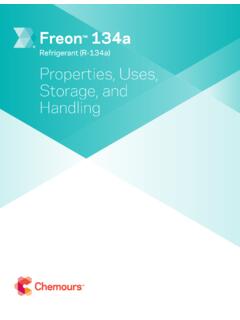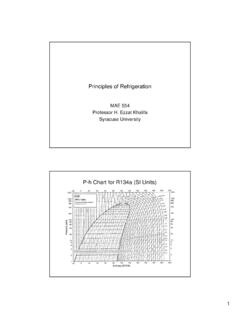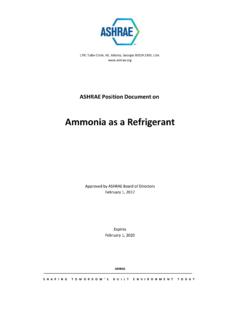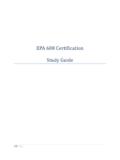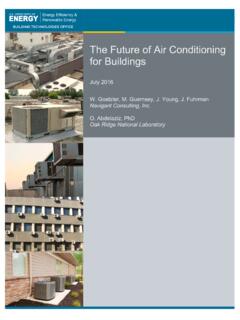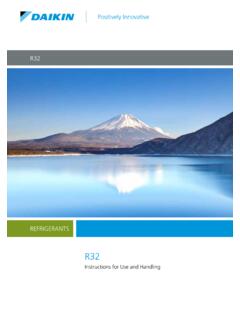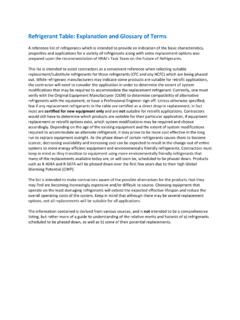Transcription of Refrigerants (R-407C and R-410A) Properties, Uses ... - Freon
1 Freon 407C and 410 ARefrigerants (R-407C and R-410A) Properties, Uses, Storage, and HandlingFreon 407C and 410 ARefrigerants2 IntroductionBackgroundChlorodifluorometh ane (R-22 or HCFC-22) has been used as a refrigerant in various refrigeration, industrial cooling, air conditioning, and heating applications for over six decades. The low ozone depletion potential (ODP) of R-22 compared to CFC-11 (chloro fluorocarbon 11) and CFC-12, as well as its excellent refrigerant properties have helped facilitate the transition away from chlorofluorocarbons (CFCs). However, R-22 will be phased out in the first quarter of the 21st century. In preparation for this phaseout, Chemours offers Freon 407C and Freon 410A, environmentally acceptable alternatives to R-22.
2 Freon 407C and Freon 410A refrigerant DescriptionsFreon 407C is a non- ozone depleting blend of three hydrofluorocarbon (HFC) Refrigerants . It exhibits performance characteristics similar to R-22. Freon 410A is a non- ozone depleting blend of two HFC Refrigerants . It exhibits higher pressures and refrigeration capacity than R-22. The compositions of Freon 407C and Freon 410A are as follows:HFC-32 HFC-125 HFC-134aFreon 407C (R-407C), wt%232552 Freon 410A (R-410A), wt%5050 Because Freon 407C and Freon 410A are mixtures of HFCs, they have zero 1 lists the chemical names and formulae of the components that make up Freon 407C and Freon 1. Components of Freon 407C: HFC-32/HFC-125/HFC-134a and Freon 410A: HFC-32/HFC-125 ComponentChemical NameFormulaCAS NumberMolecular ,1,1,2-TetrafluoroethaneCF3CH2F 407C and 410 ARefrigerants3 UsesFreon 407C refrigerant performs similarly to HCFC-22 under evaporator temperatures ranging from 7 to 10 C (20 to 50 F).
3 It is designed for use in new equipment and as a service refrigerant for existing HCFC-22 air conditioning, heat pump, and medium-temperature refrigeration 410A is intended for use in new air conditioning applications that have traditionally been serviced by HCFC-22. Many other applications are also pos sible, such as medium- and low-temperature refrigeration. Due to the significantly higher pressures that Freon 410A exhibits compared to HCFC-22, a typical compressor designed for HCFC-22 cannot be used with Freon 2 shows theoretical performance of Freon 407C, Freon 410A, and HCFC-22. Freon 407C exhibits similar performance to HCFC-22, while Freon 410A gives significantly higher pressure and refrigeration PropertiesGeneral physical properties for Freon 407C and Freon 410A are shown in Table 3.
4 The pressure-enthalpy diagrams for Freon 407C are shown in Figures 1 and physical property data may be found in other Chemours publications. Thermodynamic properties booklets are also available for Freon 407C and Freon 410A in both English and metric units. Piping guidelines are also available for Freon 2. Theoretical Cycle Performance HCFC-22 Freon 407C (R-407C) Freon 410A ( R-410A) Refrigeration Capacity (HCFC-22 = ) of Performance (HCFC-22 = ) Discharge Temperature, Discharge Pressure, kPa166117872622 Temperature Glide, : C (110 F) C (45 F) C (5 F) of C (15 F) of superheatFreon 407C and 410 ARefrigerants4 Table 3. General Property Information: Freon 407C, Freon 410A, and HCFC-22 PropertyUnitFreon 407C (R-407C) Freon 410A ( R-410A) HCFC-22 Molecular Pressure at 25 C (77 F)kPa Point (1 atm) C F Temperature C PressurekPa Densitykg/m3 (Liquid) at 25 C (77 F)kg/m3 (Saturated Vapor) at 25 C (77 F)kg/m3 Heat, Liquid at 25 C (77 F)kJ/kg KBtu/lb ( F) Heat, Liquid at 25 C (77 F) (1 atm)kJ/kg KBtu/lb ( F) Pressure of Saturated Liquid at 25 C (77 F) , kPa (psig)kPa of Vaporization at Boiling PointkJ/ Conductivity at 25 C (77 F)LiquidVapor (1 atm)W/m KBtu/hr ft ( F)W/m KBtu/hr ft ( F) at 25 C (77 F)LiquidVapor (1 atm)Pa sPa x 10 x 10 x 10 x 10 x 10 x 10 5 Flammability Limits in Air (1 atm)vol%NoneNoneNoneOzone depletion potential (ODP)
5 (CFC-11, ODP = 1) Global Warming potential (HGWP)(CFC-11, ODP = 1) Warming potential (GWP)CO2, GWP = 1 (100 yr ITH)160018901700 TSCA Inventory StatusIncludedYe sYe sYe sWorkplace Environmental Exposure Level (WEEL)*ppm (v/v) 8- and 12-hr TWA100010001000*Established by Occupational Alliance for Risk Science (OARS) Freon 407C and 410 ARefrigerants5 Figure Pressure-Enthalpy Diagram for Freon 407C (ENG Units) Freon 407C and 410 ARefrigerants6 Figure Pressure-Enthalpy Diagram for Freon 407C (SI Units) Freon 407C and 410 ARefrigerants7 Figure 3. Pressure-Enthalpy Diagram for Freon 410A (ENG Units) Freon 407C and 410 ARefrigerants8 Figure 4. Pressure-Enthalpy Diagram for Freon 410A (SI Units) Freon 407C and 410 ARefrigerants9 Chemical/Thermal StabilityStability with MetalsStability tests for Refrigerants with metals are typically performed in the presence of refrigeration lubricants.
6 This test is run in sealed glass tubes at temperatures much higher than those encountered in refrigeration and air conditioning systems and, therefore, referred to as an accelerated aging test. Results of sealed tube stability tests for HCFC-22/mineral oil and alkyl benzene lubricants have shown long-term stability in contact with copper, steel, and aluminum. And, the fact that HCFC-22/mineral oil and alkylbenzene systems have been performing in the field in air conditioning and refrigeration systems for the last 60 years verifies the results from these stability tests. Polyol ester lubricants (POEs) are for use with Freon 407C and Freon 410A. Therefore, stability tests of these Refrigerants with POEs and metals were performed. The test method followed was generally the same as ASHRAE 97 with several minor modifications.
7 A 3-mL volume of refrigerant /lubricant solution was heated in the presence of copper, steel, and aluminum coupons in an oven for 14 days at 175 C (347 F) or 200 C (392 F) for 14 days. Both the neat refrigerant and a mixture of lubricant and refrigerant (50/50 volume ratio) were tested. Stability and visual ratings were obtained on both the liquid solutions and metal coupons after the designated exposure time. The stability ratings range from 0 to 5, with 0 being the best and 5 being the worst. Visual ratings indicate how the metal or refrigerant or lubricant/ refrigerant solution appeared to a visual inspection. A rating of 0 indicates no perceptible change in appearance. Any perceptible change of color, clarity, or surface finish changes the rating to 1.
8 Mixtures of CFC Refrigerants and conventional mineral oils generally get a rating of 3, which is the limit of acceptability. The new Refrigerants and lubricants must outperform those being replaced in order to be considered the visual ratings were obtained, sample tubes were opened and the lubricant and refrigerant were analyzed. The lubricant was typically checked for halide content and breakdown products, while the refrigerant was examined for the presence of decomposition products. Table 4 summarizes the data from these sealed tube stability tests for Freon 407C and Freon 410A and various commercial POE lubricants. Stability and visual ratings are listed for the neat refrigerant , the lubricant/ refrigerant solution, and the three metals that were present in the lubricant/ refrigerant solutions.
9 Samples were analyzed for decomposition products in most cases. Typical level measurements for decomposition products, if they are detected, are in the low parts per million (ppm) results obtained from these sealed tube stability tests for Freon 407C/POEs and Freon 410A/POEs indicate acceptable chemical stability in the presence of common metals used in refrigeration and air conditioning : Lubricant/ refrigerant combinations shown throughout this bulletin are for purposes of comparing and illustrating the stability and compatibility of different lubricants with Freon Refrigerants . No recommendation is made or implied. Contact your original equipment manufacturer (OEM) for the recommended lubricant for use with Freon 4. Stability of Freon 407C and Freon 410A with Metals and Polyol Ester LubricantsStability Tests and Visual RatingsFreon 407C with Castrol SW32 Freon 407C with Castrol W22 Freon 407C with Lubrizol RL32 Freon 410A Mobil EAL22 Freon with CPI Solest 35 Neat refrigerant1H0000 refrigerant /lubricant01G100 Copper2T1T000 Iron1T1T011 Aluminum00000 Fluoride ionND (<7 ppm)ND (<7 ppm)ND (<7 ppm)ND (<7 ppm)ND (<7 ppm)Stability Ratings.
10 0 5 (Visual Ratings)0 Best ND Not determined1 First detectable change P Clear, brown3 Equivalent to CFC/mineral oil T Tarnish (moderate discoloration or light corrosion) G Gel5 Coked (heavy solids or corrosion) H HazeFreon 407C and 410 ARefrigerants10 Thermal DecompositionLike HCFC-22, Freon 407C and Freon 410A Refrigerants will decompose when exposed to high temperatures or flame sources. Decomposition may produce toxic and irritating compounds, such as hydrogen fluoride. The decomposition products released will irritate the nose and throat. Therefore, it is important to prevent exposure to decomposition products by following Chemours Safety Data Sheet (SDS) recommendations for Concerns If HCFC-22 and Freon Refrigerants Are MixedHCFC-22 and Freon Refrigerants are chemically compatible with each other.

